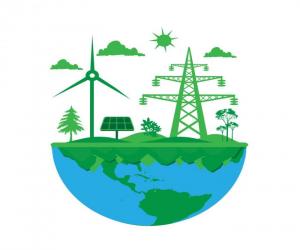- Home
- Agencies
- Department of Agriculture
- Department of Housing and Urban Development
- General Services Administration
- Department of Commerce
- Department of the Interior
- National Aeronautics and Space Administration
- Department of Defense
- Department of Justice
- National Science Foundation
- Department of Education
- Department of Labor
- Office of Personnel Management
- Department of Energy
- Department of State
- Small Business Administration
- Environmental Protection Agency
- Department of Transportation
- Social Security Administration
- Department of Health and Human Services
- Department of the Treasury
- U.S. Agency for International Development
- Department of Homeland Security
- Department of Veterans Affairs
- Goals
- Initiatives
- Programs
Renewable Energy Resource Development
Since 2009, the Department of the Interior has approved the development of 16,000 megawatts of capacity for power generation or transmission using renewable energy resources; enough to potentially power approximately 5 million homes

What is the Issue?
Onshore, the Department of the Interior’s (DOI) Bureau of Land Management (BLM) identified 20.6 million acres of public land with wind energy potential in 11 western states, 30 million acres with solar energy potential in six southwestern states, and 111 million acres of public land in western states and Alaska with geothermal resource potential. Offshore, DOI’s Bureau of Ocean Energy Management (BOEM) manages the Outer Continental Shelf, 1.7 billion acres of federal-offshore lands with enormous wind-energy potential.
As manager of one-fifth of the nation’s landmass and 1.7 billion acres of the outer continental shelf, DOI plays a major role in implementing the Obama Administration’s “Smart from the Start” strategy to develop all appropriate sources of renewable and conventional energy on U.S. managed areas. Responsible development of conventional and renewable resources on DOI managed lands and waters involve processing applications in a focused manner with full environmental analysis and public review. By advancing renewable energy, DOI helps America produce more energy at home, reducing our dependency on foreign oil while supporting a growing economy, creating jobs, and reducing greenhouse gas emissions.
What was the Intervention?
In 2009, DOI initiated a goal to increase its authorizations for developing generation or transmission capacity from renewable energy resources (solar, wind, and geothermal) in federally managed areas. Onshore, DOI maintains a renewable energy project list and ensures the progress of those applications, in terms of the necessary public participation and environmental analysis under applicable Federal and state laws, toward timely project approval. Interior tracks these projects through multi-bureau meetings to ensure issues are resolved in a timely manner. Additionally, for every project on the list, BLM posts the status at each critical stage of the renewable energy project approval cycle conducted in accordance with the principles of the National Environmental Policy Act. These projects can be reviewed through the BLM’s renewable energy website at http://www.blm.gov/wo/st/en/prog/energy/renewable_energy.html.
Offshore, the Bureau of Ocean Energy Management (BOEM) conducts lease sales for wind and wave renewable energy development as well as offshore energy transmission lines. To assess sites on the Outer Continental Shelf (OCS) for potential renewable energy projects, BOEM works closely with State, tribal and local stakeholders and industry to develop and implement a regulatory framework for offshore renewable energy and to identify Wind Energy Areas that have the highest potential wind resources and fewest competing use conflicts. Focusing development in these pre-approved areas expedites the permitting and approval process. More information is available at http://www.boem.gov/Renewable-Energy/.
How was performance management useful?
Regularly tracking performance toward the goal of approved capacity (in megawatts) for using renewable energy resources in Quarterly Status Reviews signaled managers in advance that the goal was not being achieved and that alternate action was needed. This brought together the multiple bureaus that were involved to jointly determine the factors interfering with the approval of the projects and develop a solution. Through these collaborations an alternate solution for dealing with sensitive bird species and concerns for obstructing landscapes was developed by substituting more acceptable sites. The initiative was put back on track to approving 20,000 megawatts of capacity from renewable energy resources by 2020.
What was the impact?
Prior to 2010, DOI had approved only 2,500 megawatts of wind and geothermal energy projects, but no solar energy projects. Since 2009, DOI has approved over 60 renewable energy projects including 25 solar facilities, 10 wind projects, 11 geothermal projects, and 20 transmission or connected action projects that help connect to the power grid. When built, these projects will provide more than 16,000 megawatts of power, or enough electricity to power approximately 5 million homes, produced from renewable energy resources, while providing over 24,000 construction and operations jobs.





